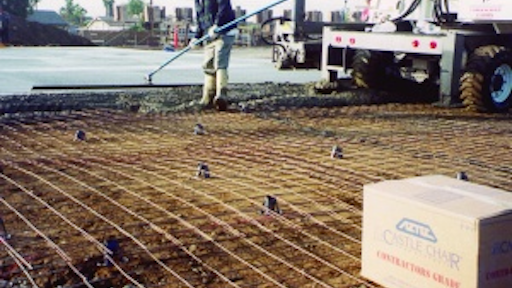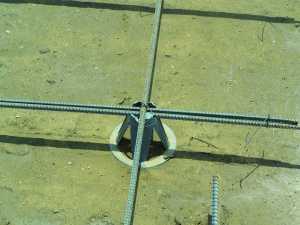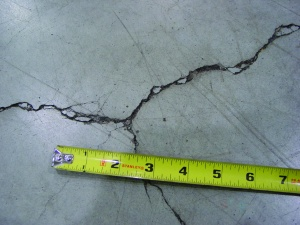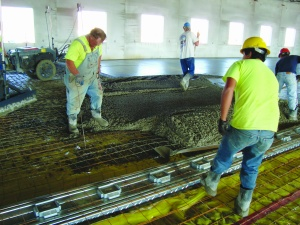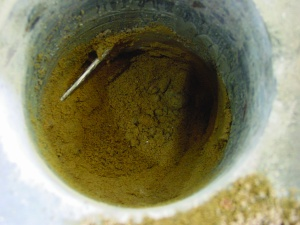*** #ကြန္ကရိ #Durability (၁) ***
( UNICODE အောက်မှာ ပါသည် )
လြန္ခဲ့တဲ့ တပတ္က ကြန္ကရိ Durability အေၾကာင္း ေဆြးေႏြးၾကမယ္ ဆိုျပီး အစျပဳခဲ့တဲ့ အခ်ိန္မွာဘဲ " သီရိမဂၤလာေစ်းေဟာင္းဆားေငြ႔ရိုက္ဒဏ္ေၾကာင့္ ၾကံ့ခိုင္မွဳေလ်ာ့နည္းလာ၍ အႏၱရာယ္ရွိ အေဆာက္အအုံအျဖစ္သတ္မွတ္ျဖိဳဖ်က္မည္" ဆိုတဲ့ သတင္းေတြ႔လိုက္မိတယ္၊ မိတ္ေဆြတစ္ဦးေျပာျပခ်က္အရ အဲဒီ အေဆာက္အအုံ သက္တမ္းက ၁၈ ႏွစ္ပဲ ရွိေသးတယ္လို႔ သိရပါတယ္။
ဒီအခ်က္ကိုၾကည့္ျခင္းအားျဖင့္ structure design မွန္ရုံ၊ Compressive strength ေကာင္းရုံနဲ႔ တင္ ေကာင္းမြန္ တာရွည္ခံတဲ့ ကြန္ကရိအေဆာက္အအုံ တစ္ခုျဖစ္ဖို႔ မေသခ်ာဘူးဆိုတာ သိသာထင္ရွားပါတယ္။
ဒါေၾကာင့္ Durability အေၾကာင္း အခ်ိန္ရရင္ ရသလို အပိုင္းလိုက္ ေဆြးေႏြးသြားပါမယ္၊
(က) #ကြန္ကရိ #Durability ဆိုတာ ဘာလဲ
Concrete Durability ဆိုသည္မွာ ရာသီဥတုေျပာင္းလဲျခင္း( weathering action) ၊ ဓါတုပစၥည္းမ်ား၏တိုက္စားျခင္း (chemical attacck) ၊ ပြတ္တိုက္ျခင္း (abrasion) အျခားေသာယိုယြင္းပ်က္စီးမ်ား (other degration process) မ်ားကို ခုခံႏိုင္စြမ္းရွိသည့္ ကြန္ကရိ အမ်ိဳးအစားကို ေခၚပါသည္။
ကြန္ကရိ durability ကို အရိုးရွင္းဆုံး အဓိပၸါယ္ဖြင့္ပါဟုဆိုလ်င္ ရာသီဥတုဒဏ္ႏွင့္ ဓါတုပစၥည္းတို႔၏တိုက္ခိုက္မွဳမ်ားကို ၾကံ့ၾကံ့ခံႏိုင္စြမ္းရွိျပီး မူလဒီဇိုင္းတြင္သတ္မွတ္ထားသည့္ အင္ဂ်င္နီယာပိုင္းဆိုင္ရာလိုအပ္ခ်က္မ်ားအတိုင္း သက္တမ္းျပည့္ တည္ရွိေနႏိုင္ျခင္းဟု ဆိုရပါမည္။
ထို႔ေၾကာင့္ durability ေကာင္းေသာ ကြန္ကရိသည္ သိသာထင္ရွားသည့္ ပ်က္စီးယိုယြင္းျခင္းမရွိပဲ ႏွစ္ကာလ ၾကာရွည္စြာ ခိုင္ခန္႔ေနေပလိမ့္မည္၊
အေဆာက္အဦ သုံးစြဲသည့္ ပတ္၀န္းက်င္ အေနအထား (exposure) ႏွင့္ သုံးစြဲမွဳေပၚမူတည္၍ လိုအပ္သည့္ တာရွည္ခိုင္ခံ့မွဳ အတိုင္းအတာ (degree of durability) လည္း ကြဲျပားႏိုင္ပါသည္၊ ဥပမာအားျဖင့္ ဒီေရအတက္အက်ရွိသည့္ေဒသတြင္ရွိသည့္ ကြန္ကရိၾကမ္းခင္းျပင္တစ္ခု၏ durability လိုအပ္ခ်က္သည္ အျခားတစ္ေနရာတြင္ရွိသည့္ ေနအိမ္အတြင္းရွိ ၾကမ္းခင္းျပင္ တစ္ခု၏ durability လိုအပ္ခ်က္ႏွင့္ တူညီမည္မဟုတ္ပါ၊ ထို႔အတူ ျမစ္ကူးတံတားတစ္ခု၏ ပင္မတိုင္ၾကီး (pier) အတြက္ လိုအပ္သည့္ durability သည္လည္း ထိုတံတားေပၚတြင္ ခင္းထားသည့္ ၾကမ္းခင္း (deck) အတြက္ လိုအပ္သည့္ durability ႏွင့္ တူညီမည္ မဟုတ္ပါ။
ကြန္ကရိ durability အတြက္ mix design ထည့္သြင္း စဥ္းစားရမည့္ အခ်က္မ်ား
• ကြန္ကရိအေဆာက္အအုံေပၚတြင္ ပါတ္၀န္းက်င္မွ မည္သို႔ေသာ ထိခိုက္မွဳမ်ားရွိႏိုင္သနည္း၊
• ကြန္ကရိအေဆာက္အအုံကို မည္သည့္အတြက္ အသုံးျပဳမည္နည္း၊
• ကြန္ကရိအေဆာက္အအုံ၏ သက္တမ္း (lifespan) ကို မည္မွ် သတ္မွတ္ထားသနည္း၊
(ခ) ကြန္ကရိ durability ကို စဥ္းစားရာတြင္ ေအာက္ေဖၚျပပါ အဓိကအေၾကာင္းရင္း (၃) မ်ိဳးကို ထည့္သြင္းစဥ္းစားဖို႔ လိုအပ္ပါသည္။
၁) ရုပ္ေျပာင္းလဲမွဳေၾကာင့္ ျဖစ္ေပၚသည့္ အေၾကာင္းရင္းမ်ား (Physical cauces)
၂) လွဳပ္ရွားမွဳေၾကာင့္ ျဖစ္ေပၚသည့္ အေၾကာင္းရင္းမ်ား (Mechanical cauces)
၃) ဓာတ္ျပဳမွဳေၾကာင့္ ျဖစ္ေပၚသည့္ အေၾကာင္းရင္းမ်ား (Chemical causes)
အထက္ပါ အဓိကအေၾကာင္းရင္း (၃) မ်ိဳးကို ထပ္မံ၍ အေသးစိတ္အေနျဖင့္ (၁၂) မ်ိဳး ထပ္မံ ခြဲျခားႏိုင္ပါတယ္။
၁ (က) ေရခဲမွဳႏွင့္ အပူခ်ိန္ေျပာင္းလဲမွဳ တို႔ေၾကာင့္ ျဖစ္ေပၚသည့္ အေၾကာင္းရင္း (The action of frost, thermal movement)
၂ (က) ရုတ္တရက္ ၀န္အားသက္ေရာက္မွဳ (Impact)
၂ (ခ) ပြတ္တိုက္မွဳ (Abrasion)
၂ (ဂ) ေရတိုက္စားမွဳ (Erosion)
၂ (ဃ) ၾကမ္းတမ္းသည့္ ေရတိုက္စားမွဳေၾကာင့္ ကြန္ကရိမ်က္ႏွာျပင္၌ ခ်ိဳင့္ခြက္မ်ားျဖစ္ေပၚမွဳ (Cavitation)
၃ (က) ဆာလဖိတ္ဓါတ္ဆားမ်ား တိုက္ခိုက္မွဳ (Sulfate attack)
၃ (ခ) ပင္လယ္ေရငန္ တိုက္ခိုက္မွဳ (Sea water attack)
၃ (ဂ) သဲ၊ ေက်ာက္မ်ားတြင္ပါ၀င္သည့္ ဆီလီကာႏွင့္ ဘိလပ္ေျမတြင္ပါ၀င္သည့္ အယ္လ္ကာလီ ဓါတ္ျပဳမွဳ (Alkali-Silica Reaction [ASR])
၃ (ဃ) အားကူသံေခ်ာင္းမ်ား သံေခ်းစားမွဳ (Corrosion of reinforcement)
စသည္တို႔ျဖစ္ပါသည္။ (ေအာက္ေဖၚျပပါပုံတြင္ ၾကည့္ပါ)
#ကြန္ကရိ Durability (၂)
Durability ေကာင္းေအာင္ ဘယ္လိုလုပ္မလဲ -ဆက္ရန္
======================================
UNICODE
*** #ကွန်ကရိ #Durability (၁) ***
လွန်ခဲ့တဲ့ တပတ်က ကွန်ကရိ Durability အကြောင်း ဆွေးနွေးကြမယ် ဆိုပြီး အစပြုခဲ့တဲ့ အချိန်မှာဘဲ " သီရိမင်္ဂလာစျေးဟောင်းဆားငွေ့ရိုက်ဒဏ်ကြောင့် ကြံ့ခိုင်မှုလျော့နည်းလာ၍ အန္တရာယ်ရှိ အဆောက်အအုံအဖြစ်သတ်မှတ်ဖြိုဖျက်မည်" ဆိုတဲ့ သတင်းတွေ့လိုက်မိတယ်၊ မိတ်ဆွေတစ်ဦးပြောပြချက်အရ အဲဒီ အဆောက်အအုံ သက်တမ်းက ၁၈ နှစ်ပဲ ရှိသေးတယ်လို့ သိရပါတယ်။
ဒီအချက်ကိုကြည့်ခြင်းအားဖြင့် structure design မှန်ရုံ၊ Compressive strength ကောင်းရုံနဲ့ တင် ကောင်းမွန် တာရှည်ခံတဲ့ ကွန်ကရိအဆောက်အအုံ တစ်ခုဖြစ်ဖို့ မသေချာဘူးဆိုတာ သိသာထင်ရှားပါတယ်။
ဒါကြောင့် Durability အကြောင်း အချိန်ရရင် ရသလို အပိုင်းလိုက် ဆွေးနွေးသွားပါမယ်၊
(က) #ကွန်ကရိ #Durability ဆိုတာ ဘာလဲ
Concrete Durability ဆိုသည်မှာ ရာသီဥတုပြောင်းလဲခြင်း( weathering action) ၊ ဓါတုပစ္စည်းများ၏တိုက်စားခြင်း (chemical attacck) ၊ ပွတ်တိုက်ခြင်း (abrasion) အခြားသောယိုယွင်းပျက်စီးများ (other degration process) များကို ခုခံနိုင်စွမ်းရှိသည့် ကွန်ကရိ အမျိုးအစားကို ခေါ်ပါသည်။
ကွန်ကရိ durability ကို အရိုးရှင်းဆုံး အဓိပ္ပါယ်ဖွင့်ပါဟုဆိုလျင် ရာသီဥတုဒဏ်နှင့် ဓါတုပစ္စည်းတို့၏တိုက်ခိုက်မှုများကို ကြံ့ကြံ့ခံနိုင်စွမ်းရှိပြီး မူလဒီဇိုင်းတွင်သတ်မှတ်ထားသည့် အင်ဂျင်နီယာပိုင်းဆိုင်ရာလိုအပ်ချက်များအတိုင်း သက်တမ်းပြည့် တည်ရှိနေနိုင်ခြင်းဟု ဆိုရပါမည်။
ထို့ကြောင့် durability ကောင်းသော ကွန်ကရိသည် သိသာထင်ရှားသည့် ပျက်စီးယိုယွင်းခြင်းမရှိပဲ နှစ်ကာလ ကြာရှည်စွာ ခိုင်ခန့်နေပေလိမ့်မည်၊
အဆောက်အဦ သုံးစွဲသည့် ပတ်ဝန်းကျင် အနေအထား (exposure) နှင့် သုံးစွဲမှုပေါ်မူတည်၍ လိုအပ်သည့် တာရှည်ခိုင်ခံ့မှု အတိုင်းအတာ (degree of durability) လည်း ကွဲပြားနိုင်ပါသည်၊ ဥပမာအားဖြင့် ဒီရေအတက်အကျရှိသည့်ဒေသတွင်ရှိသည့် ကွန်ကရိကြမ်းခင်းပြင်တစ်ခု၏ durability လိုအပ်ချက်သည် အခြားတစ်နေရာတွင်ရှိသည့် နေအိမ်အတွင်းရှိ ကြမ်းခင်းပြင် တစ်ခု၏ durability လိုအပ်ချက်နှင့် တူညီမည်မဟုတ်ပါ၊ ထို့အတူ မြစ်ကူးတံတားတစ်ခု၏ ပင်မတိုင်ကြီး (pier) အတွက် လိုအပ်သည့် durability သည်လည်း ထိုတံတားပေါ်တွင် ခင်းထားသည့် ကြမ်းခင်း (deck) အတွက် လိုအပ်သည့် durability နှင့် တူညီမည် မဟုတ်ပါ။
ကွန်ကရိ durability အတွက် mix design ထည့်သွင်း စဉ်းစားရမည့် အချက်များ
• ကွန်ကရိအဆောက်အအုံပေါ်တွင် ပါတ်ဝန်းကျင်မှ မည်သို့သော ထိခိုက်မှုများရှိနိုင်သနည်း၊
• ကွန်ကရိအဆောက်အအုံကို မည်သည့်အတွက် အသုံးပြုမည်နည်း၊
• ကွန်ကရိအဆောက်အအုံ၏ သက်တမ်း (lifespan) ကို မည်မျှ သတ်မှတ်ထားသနည်း၊
(ခ) ကွန်ကရိ durability ကို စဉ်းစားရာတွင် အောက်ဖေါ်ပြပါ အဓိကအကြောင်းရင်း (၃) မျိုးကို ထည့်သွင်းစဉ်းစားဖို့ လိုအပ်ပါသည်။
၁) ရုပ်ပြောင်းလဲမှုကြောင့် ဖြစ်ပေါ်သည့် အကြောင်းရင်းများ (Physical cauces)
၂) လှုပ်ရှားမှုကြောင့် ဖြစ်ပေါ်သည့် အကြောင်းရင်းများ (Mechanical cauces)
၃) ဓာတ်ပြုမှုကြောင့် ဖြစ်ပေါ်သည့် အကြောင်းရင်းများ (Chemical causes)
အထက်ပါ အဓိကအကြောင်းရင်း (၃) မျိုးကို ထပ်မံ၍ အသေးစိတ်အနေဖြင့် (၁၂) မျိုး ထပ်မံ ခွဲခြားနိုင်ပါတယ်။
၁ (က) ရေခဲမှုနှင့် အပူချိန်ပြောင်းလဲမှု တို့ကြောင့် ဖြစ်ပေါ်သည့် အကြောင်းရင်း (The action of frost, thermal movement)
၂ (က) ရုတ်တရက် ၀န်အားသက်ရောက်မှု (Impact)
၂ (ခ) ပွတ်တိုက်မှု (Abrasion)
၂ (ဂ) ရေတိုက်စားမှု (Erosion)
၂ (ဃ) ကြမ်းတမ်းသည့် ရေတိုက်စားမှုကြောင့် ကွန်ကရိမျက်နှာပြင်၌ ချိုင့်ခွက်များဖြစ်ပေါ်မှု (Cavitation)
၃ (က) ဆာလဖိတ်ဓါတ်ဆားများ တိုက်ခိုက်မှု (Sulfate attack)
၃ (ခ) ပင်လယ်ရေငန် တိုက်ခိုက်မှု (Sea water attack)
၃ (ဂ) သဲ၊ ကျောက်များတွင်ပါ၀င်သည့် ဆီလီကာနှင့် ဘိလပ်မြေတွင်ပါ၀င်သည့် အယ်လ်ကာလီ ဓါတ်ပြုမှု (Alkali-Silica Reaction [ASR])
၃ (ဃ) အားကူသံချောင်းများ သံချေးစားမှု (Corrosion of reinforcement)
စသည်တို့ဖြစ်ပါသည်။ (အောက်ဖေါ်ပြပါပုံတွင် ကြည့်ပါ)
#ကွန်ကရိ Durability (၂)
Durability ကောင်းအောင် ဘယ်လိုလုပ်မလဲ -ဆက်ရန်
Credit -
U San Nwe






